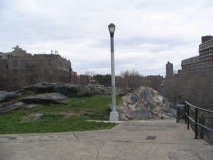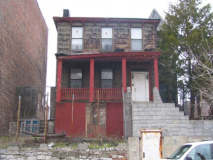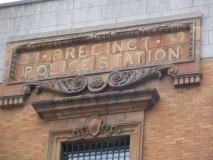 “I’m in the mood for Easter everywhere,”once sang idiosyncratic “Arch-drude” British psychedelicist Julian Cope*, and so was your webmaster as he stormed the Bronx for what must have been the first time in months on April 8, 2007. Unfortunately the weatherman wasn’t, as conditions were rather more reminiscent of Thanksgiving, with a temperature of about 40 and wind gusts of about the same. But free time is free time, and should never be wasted because of mere things like stiff breezes…
“I’m in the mood for Easter everywhere,”once sang idiosyncratic “Arch-drude” British psychedelicist Julian Cope*, and so was your webmaster as he stormed the Bronx for what must have been the first time in months on April 8, 2007. Unfortunately the weatherman wasn’t, as conditions were rather more reminiscent of Thanksgiving, with a temperature of about 40 and wind gusts of about the same. But free time is free time, and should never be wasted because of mere things like stiff breezes…
*I was all ready to attribute the song to Roky Erickson, only to discover that Cope had copped the title from an LP by Erickson’s 1960s band, the13th Floor Elevators.
Mount Hope Court, 1882 Grand Concourse at East Tremont Avenue, was completed in 1914 and was once the tallest building in The Bronx at ten stories.
The destination today was the East Tremont section, located, in general, from the Grand Concourse east to Crotona Avenue and from Crotona Park north to East 180th Street, but it’s hard to say where it bleeds into its neighbors, West Farms and Belmont. Area denizens would probably be able to say better.
The genesis of Tremont’s name is similar to that of Boston’s: while that city’s Tremont Street was named for three hills on the originally narrow peninsula where Boston grew and prospered, so the Bronx’ Tremont was named in he mid-1800s by its first postmaster Hiram Tarbox for three hills in mid-Bronx: Mount Eden, Mount Hope and Fairmount. The main difference is that Bostonians pronounce it TREH’ mont, while Bronxites say TREE’ mont.
WAYFARING: EAST TREMONT-ECHO PARK
Mount Hope Place runs between Jerome Avenue and Anthony Avenue north of East 176th Street. It contains a group of homes that have pretty much remained intact for at least nine decades if not longer.
Stoned, Immaculate

You’ll find a genuine suburban mansion at Anthony Avenue and East 176th Street. In 1896 Edwin Shuttleworth, a stone dealer, approached the Neville & Bagge architectural firm with the idea of creating a house using one of the varieties of stone he sold. The architects embellished the plan by bringing in stone carvers who created ornate male and female forms, marine elements and picturesque busts. It remains one of the few suburban mansions left in The Bronx.

Front dormer

Front porch bay on the Mount Hope Place side

Seen from Mt. Hope Place


Mount Hope Place side. Could these be representations in stone of Edwin and Elizabeth Shuttleworth? Spooky.


Anthony Avenue side. Caryatids guard the front porch door. Actually since they are male the correct term is telamones, or even atlantes (plural of Atlas). wikipedia
Echo Park, faraway in time

The retro-Gothic Tremont Baptist Church lords it over the complicated intersection of East Tremont, Valentine and Webster Avenues. But the real attraction is across the street…

Ice-age era rock encrustations dominate Julius Richman Park, as it’s officially called. With all due respect to Richman (1915-1973) chairman of the Twin Parks Association and the Urban Action Task Force, and Assistant Administrator of the City’s Finance Committee, “Julius Richman Park” simply doesn’t carry the mojo of the park’s old name, Echo Park, so named because sound waves can ricochet and bounce off these incredible reminders of the Ice Age and return to the persons who originated them.
Probably, the Bronx street grid predated dynamite.
Had this part of The Bronx been settled at a later date (the early to mid-1800s, it’s quite likely this inconvenient rock escarpment would have simply been blown up so that East Tremont Avenue could proceed on a simple east-west course. Cannon could have been used, but that may have proved impractical. But the busy road merely curves around the escarpment, as does Valentine Avenue, which begins its northward trek to Fordham here.
The Bronx tries its darndest to conform to a grid pattern. But odd colonial trails spider-web off all over the borough, and natural formations like this spoiled the gridmasters’ party.
Northern Manhattan and The Bronx feature these surprising formations much more often than do the other three boroughs.
One of my favorite old 1950s monster movies is The Monolith Monsters, starring Grant Incredible Shrinking Man Williams, in which alien rocks grow to giant crystalline towers and threaten to envelop the San Fernando Valley. A little salt water, and problem solved, but what if these things ever decided to animate…

Webster Hotel, Webster Avenue north of East Tremont, boasts a park view.

El Rancho, formerly NY Capital Bank, East Tremont and Park.
Webster Avenue, one of The Bronx’ longest throughfares, assumes the pathways of Willis and Melrose Avenues to its south (accepting traffic from Manhattan’s 1st Avenue via the Willis Avenue Bridge) and extends into Westchester County as Bronx River Road. It is likely named for post-Civil War Public Works engineer Albert Webster or surveyor Joseph Webster.


Frank’s, a venerable sports goods shop on East Tremont between Webster and Park, boasts an old neon sign on its eastern end.
I had expected to find a somewhat decrepit commuter station here, since our commuter railroads (Metro North and Long Island Rail Road) tend to be lax on upkeep of their inner city stops, but was I fooled here at Tremont Station at East Tremont and Park Avenue: it’s been given a throrough makeover with new plastic anti-skid mats near The Gap, new staircases, and new lighting. Lighting trends have evolved toward shining the beam straight up so it reflects on a shiny panel.
Park Avenue is an extension of Manhattan’s Park Avenue, but Mrs. Douglas wouldn’t recognize it here.
Bathgate Avenue north of East Tremont. Ancient house plus the old 48th Precinct Police Station: note the alternating arched and triangular pediments over the second story windows. See this page for additional old Bronx police stations.
Much of East Tremont, Crotona Park and Belmont lie on the farm belonging to the Bathgate family in the mid-1800s. The Bathgates were originally employed by the Morris family as surveyors and overseers.
Third Avenue in The Bronx is the northern extension of Manhattan’s 3rd Avenue that begins at Cooper Square. (Those respective spellings are used on official Department of Transportation street signs.) In 1891, a number of different streets including a section of the colonial-era Kingsbridge Road were renamed Third Avenue when the famous elevated railroad was extended to The Bronx. The el shut down in 1955 in Manhattan, and hung in there from The Hub to White Plains Road until 1973 in The Bronx.


A section of trolley track has been exposed as the pavement wears off at East Tremont and Third Avenues. Meanwhile, an ornate, arched staircase enters a large field of green, Tremont Park, on the southwest corner.
This park was once named Old Borough Hall Park, because Borough Hall stood on this property. George B. Post (1837-1913) designed Bronx Borough Hall with yellow brick and brown terra-cotta trim. Post’s most famous accomplishments include the New York Stock Exchange and the now demolished Western Union Building, which stood at Broadway and Dey Street in Manhattan. Bronx Borough Hall was completed in 1897, and Louis F. Haffen, the first Bronx Borough President, was inaugurated in a second floor office in 1898. In 1899, a grand stairway was constructed along the steep slope down to Third Avenue, connecting Borough Hall to the bustling Bronx.
After World War I, Victory Park, a formal garden with paths radiating from a large circular fountain, was created near Borough Hall to celebrate the Allied victory over Germany. Borough Hall served as the borough’s administrative headquarters until a new Bronx administration building was constructed along the Grand Concourse near Yankee Stadium in 1935. Government services gradually left the old Borough Hall, and by 1964, the only office left in the building was a marriage license bureau. Despite efforts by the Bronx County Historical Society and others to renovate the hall for civic use, the building was deemed structurally unsafe and demolished on January 12, 1969. NYC Parks

The 1899 staircase once led to Borough Hall…

…it’s worn, yet astoundingly graffiti-free.

The view at the top is nothing special.

…but there’s a rise on the other side of Tremont Park.


That’s better! Could this be one of the three hills, Mount Hope, Mount Eden, or Fairmount, mentioned by the postmaster who named Tremont.
Photographed April 8, 2007; page completed April 22, 2007
erpietri@earthlink.net
©2007













